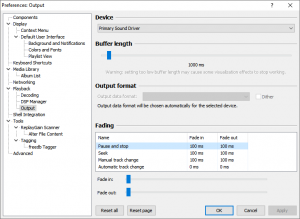Foobar2000:Preferences:Output: Difference between revisions
Shakey snake (talk | contribs) No edit summary |
Shakey snake (talk | contribs) No edit summary |
||
| Line 1: | Line 1: | ||
{{fb2k prefs}} | {{fb2k prefs}} | ||
[[Category:foobar2000 Preferences|Output]] | [[Category:foobar2000 Preferences|Output]] | ||
[[Image:Foobar2000-Preferences-output.png]] | [[Image:Foobar2000-Preferences-output.png|thumb|left|Screenshot]] | ||
== Output Device == | == Output Device == | ||
Revision as of 23:03, 25 April 2010

|
foobar2000 Preferences |
|---|---|
[[File:{{{1}}}|210px|frameless|none|Screenshot of the {{{2}}} page]]
Deprecated pages Pages marked * are added via third-party components. | |

Output Device
Controls the physical device that played audio stream is sent to. Commonly available options include:
- Primary Audio Driver - your system default audio device as configured in Windows Sound control panel.
- Null Output - does nothing; useful mainly for development/testing purposes.
Additional output devices can be added using optional output components.
Buffer Length
To protect playback from glitches during heavy system load or file access lag, resource-heavy operations such as decoding and DSP are always performed ahead of currently heard sound (this is not unique to foobar2000, all or nearly all media players behave this way). This setting controls the distance between decoding/DSP and output.
- High buffer sizes offer stronger protection against glitches but introduce side effects such as long delay between changing DSP settings (eg. adjusting equalizer bands) and changes in sound output.
- Low buffer sizes allow faster responses to DSP configuration changes at cost of higher risk of stuttering during high system load / file access lag / etc.
WARNING: Setting too low buffer length may cause certain visualizations to stop working correctly. Use of buffer lengths below 500ms is not recommended.
Output Format
Controls the audio data format passed to the operating system / audio drivers / etc. You should refer to your soundcard's documentation to find the optimal setting; using bit depth higher than supported by your hardware might work but will not improve output audio quality in any way and may degrade performance.
Note that this option is not available with some output modes such as ASIO - ASIO architecture doesn't support variable data formats by design, the format that needs to be sent is determined by the driver.
Dither
Dithering can be used to improve quality of 16-bit playback in certain cases. However, it uses lots of extra CPU power and is not recommended for general use.
